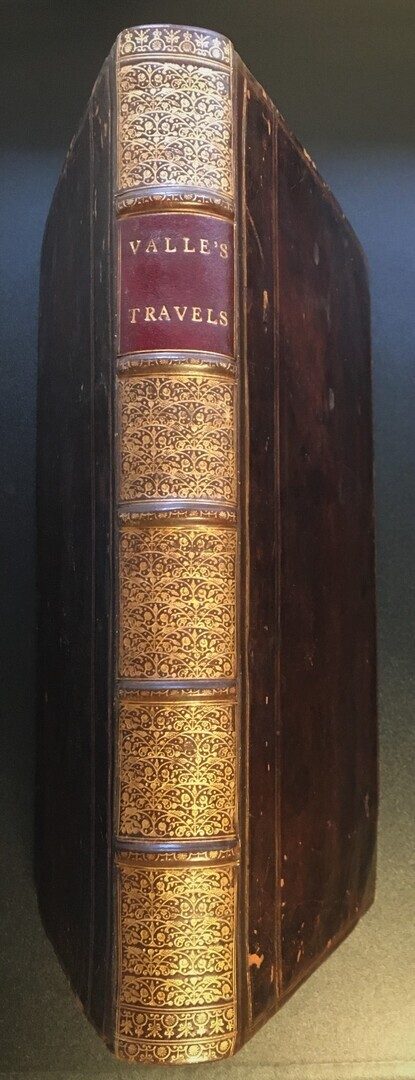The Travels of Sig. Pietro della Valle, a noble roman into East-India and Arabia Deserta … Whereunto is added A Relation of Sir Thomas Roe’s Voyage into the East-Indies.
Della Valle, Pietro.
Synopsis
FIRST EDITION IN ENGLISH OF THIS FASCINATING VIEW OF THE EAST AT THE HEIGHT OF THE MOGHUL EMPIRE, comprising the third part of the author’s Viaggi … cioè la Turchia, la Persia, e l’India. The text comprises a series of fifty-four letters written to the physician Schipano of Naples during Valle’s extensive tour. “Disappointed in love and filled with a desire to see the world” (Penrose), Della Valle left Venice in 1614 on a pilgrimage to Palestine. From Sinai he proceeded to Damascus and Aleppo, then crossed Mesopotamia to Baghdad, thence into Persia where he married the Circassian Setti Manni, who accompanied Della Valle on his further travels. In Persia he spent some time at the court of Shah Abbas, but his wife died at Persepolis in 1623.
His travels took him farther east to the coast of India as far as Calicut, and from Goa to Muscat, thence to Aleppo by way of Basra, finally reaching Rome in 1626. Della Valle’s personal wealth allowed him to travel and observe at will. His account includes detailed descriptions of music, dance and food, whereas Thomas Roe’s account contains descriptions of his voyage, religion, society, customs and governance.
Pietro Della Valle was one of the most remarkable travellers of the seventeenth century; he was also a leading figure in the cultural life of his age. Unlike most travellers of the time, he was motivated by ethnographical, linguistic and artistic matters, rather than trade, conquest or missionary zeal. He signs himself here as “il pellegrino” (the pilgrim), but in the largely secular sense of seeking to broaden his aristocratic classical education by embracing the civilizations of the East – including eventually an eighteen-year-old girl, whom he married in 1616 and whose death in childbirth in 1623 precipitated his return to Italy.
Della Valle first traces his voyage from Rome to Constantinople via Ancona, Bologna, Ferrara and Venice across to observe the great ruins of Troy (“…per dire meglio Campos ubi Troia fuit e vedute le gran ruine di quella famosa Città…”) and the Hellespont, pointing out Abydos and Sestos, made famous by the tale of Hero & Leander. He arrived at Constantinople on 15 August 1614 and describes the opening of the Dardanelles at the Black Sea, and Scutari.
He describes his voyages as well as the cities he visited, including travelling with camels, which he judges much slower and more troublesome than horses. There is a dramatic description of crossing the River Mehi in India, using elephants and local oxen, made difficult by the converging currents from the river and the sea-water. Elsewhere he reports cultural, linguistic and artistic curiosities of the places he visits, often sending back examples of his finds to Italy. Many are still conserved in museums in Rome and Dresden.
Della Valle’s travelogues were published through many editions and in different languages. The greatest numbers of letters are dated from Persia (n. 1-18), ten letters from Constantinople and four from India.
Bibliographic references: Blackmer 1712 (first French edition); Rohricht 947; Tobler p. 95; Macro, Bibliography of the Arabian Peninsula, 2233; Wilson 234; Wing V48A; Kress 1167; Cf. Goldsmith 1153.








